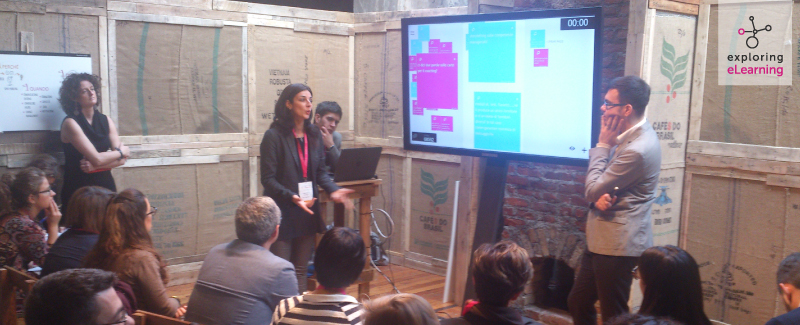As a blended training tool, posterLab is inspired by the scientific posters that are used in conferences to present, in summary format, the description and results of research. They are used Just like the discussions held around posters at conferences, in order for the participants to update each other, exchange know-how and stimulate each other to carry out further and more in-depth research. The module developed by Amick Education, the result of thirty years of research, study, experimentation and practice, takes numerous theoretical issues into account, which we try to list.
Zygmunt Bauman
The traditional classroom becomes fluid. There is no longer a teacher. Instead, there is an expert who acts as a facilitator, manages the contributions of participants and the timing of the performance. A testimonial tells us how he put this approach into practice. The participants send their contributions through APP and continue to participate in the practice community that is created around the posterLab. Even the training does not have specific times that separate in terms of work or leisure it can instead happen at any time. The topics, programmes and materials are no longer rigid and pre-defined, but aggregate and disaggregate themselves by being worked on by the practice communities. http://bit.ly/1YR18Hh
Henry Levy
Collective intelligence builds know-how shared between the coach, tutor, testimonial and participants.
Derrick De Kerkhove
Connective intelligence creates a micro-network among the participants, classroom and community. http://www.umbertosantucci.it/intelligenza-collettiva-e-connettiva/
Howard Gardner
Multiple intelligence issubject to the use of multimedia and multimodal languages.
Joseph Novak and Toni Buzan
Significant learning is structured via conceptual and mental maps, which often forming the figurative basis of posters.
Rudolph Arnheim
Visual thinking is the basis of all display processes used to reduce complexity, from prior research to the realisation of a poster. http://www.einaudi.it/libri/libro/rudolf-arnheim/il-pensiero-visivo/978880634405
Dee Hoch
The distributed leadership of Dee Hoch, founder and CEO of Visa Inc., is a recursive distributed leadership model based on a systemic loop in which leadership is exercised both on peers, superiors and lower levels, thus being distributed throughout an organisation. The basic self-control guarantees proper functioning in turbulent and complex situations. A posterLab is a small “expert” practice community, since it learns by doing things, is self-sufficient, since it in any case works on a self-regulating basis, because it adapts to the diversity of topics and participants. http://www.umbertosantucci.it/tag/dee-hoch/
Schwaber and Sutherland
They are the originators of agile project management, the so-called “scrum” method, from the rugby scrum, where you don’t know what’s going to happen until the ball comes out and the action starts. The scrum is based on delegation to working groups that provide a real and functional output for each work package, but are not controlled during the development process. The method is eminently suitable for high turbulence IT projects. A posterLab behaves like a scrum team. https://it.wikipedia.org/wiki/Scrum_(informatica)
Nonaka and Takeuchi
A learning organisation is a company that is not fossilized on acquired knowledge, but continues to learn, moving from tacit and implicit knowledge to shared and explicit knowledge. A posterLab is an “expert” training system, since it learns by doing and working through the continuous contribution of the coach, tutor, testimonial and participants. http://bit.ly/1RfBSo7
Vincenzo Petruzzi
Gamification intervenes in a posterLab because the contributions of the participants are selected and rewarded. Also, the game and simulation are regarded as being important during the entire exercise, and in the practice community. Petruzzi collaborates in the posterLab project and is the author of “The Power of Gamification. Using games to create changes in attitudes and individual performance”, Franco Angeli.
Fontana, Vogler
Storytelling has been widely used to develop the narrative side of video presentations regarding poster topics. The narrative model is proposed by Chris Vogler. Digital storytelling – http://bit.ly/1Efh5L1  A posterLab can start with 40 minutes of classroom training, or with a forum proposed by the practice community. The classroom can be unstructured, informal, even an outdoor space, or it can be organised with a large IWB (interactive whiteboard) that displays magenta or cyan coloured post its, which are sent through a specific APP by mobile participants. Just now, as shown by the clock in the upper right of the IWB, time is up and the testimonial answers a few questions from the participants. Standing on the right is the conductor (in this case Marco Amicucci), to left at the notebook is the technical assistant and tutor who acts as a facilitator for all the participants. The function of the paper poster that can be seen on the far left is to keep the participants’ focused on the posterLab topic’s visual map. Umberto Santucci www.umbertosantucci.it
A posterLab can start with 40 minutes of classroom training, or with a forum proposed by the practice community. The classroom can be unstructured, informal, even an outdoor space, or it can be organised with a large IWB (interactive whiteboard) that displays magenta or cyan coloured post its, which are sent through a specific APP by mobile participants. Just now, as shown by the clock in the upper right of the IWB, time is up and the testimonial answers a few questions from the participants. Standing on the right is the conductor (in this case Marco Amicucci), to left at the notebook is the technical assistant and tutor who acts as a facilitator for all the participants. The function of the paper poster that can be seen on the far left is to keep the participants’ focused on the posterLab topic’s visual map. Umberto Santucci www.umbertosantucci.it